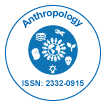
Anthropology
Open Access
ISSN: 2332-0915

ISSN: 2332-0915
Short Communication - (2021)Volume 9, Issue 4
This basic article outlines the boundaries of an arising field of clinical humanities, human creature wellbeing, and its potential for reorienting the control. Ethnographic investigations of how creatures are embroiled in wellbeing, well‐being, and pathogenicity permit us to return to hypotheses of focal points in clinical human sciences, prominently environment, biopolitics, and care. In the interim, the states of the Anthropocene constrain us to grow new devices to consider human creature snare.
Humans; Animals; Medical Anthropology; Health
This basic article outlines the boundaries of an arising field of clinical humanities, human creature wellbeing, and its potential for reorienting the control. Ethnographic investigations of how creatures are embroiled in wellbeing, wellâ?being, and pathogenicity permit us to return to hypotheses of focal points in clinical human sciences, prominently environment, biopolitics, and care. In the interim, the states of the Anthropocene constrain us to grow new devices to consider human creature snare.
Nonhuman creatures are our accomplices in regular day to day existence. As pets, animals, and natural life, creatures are altogether implanted in practices of development, utilization, and coâ?habitation. This has significant ramifications for wellbeing and recuperating. The security and wealth of our food are subject to the government assistance of animals, yet worries about the ascent of antimicrobial opposition uncover conceivably calamitous crossing points between escalated creature creation and new types of pathogenicity. Contact with wild and homegrown creatures can set out open doors for pandemic episodes. Human aggravations to creature environments are censured for a progressing mass annihilation of creatures. There is developing proof of the commitment that partner and treatment creatures make to passionate and physical wellâ?being. Living admirably with different creatures is fundamental for the government assistance, everything being equal. In reality, it is likely among the most squeezing and pressing issues within recent memory. This assortment traces an arising space of clinical humanities: human creature wellbeing. The givers investigate issues of human–creature contact, coâ?habitation, and partition in settings where set up scholarly ideal models are tested by new ecologies, entertainers, and issues. By uncovering both how biopolitics reaches out past the human and how practices of care cross species limits, human creature wellbeing reorients our comprehension of wellâ?worn worries in clinical human sciences. writing that has made the human interface focal in inquiries of general wellbeing, clinical medication, nourishment, and lab science. All things considered, a large number of the supporters wound up amazed to compose material that could be classed as clinical humanities. Pondering the fecal remnants of creature creation (Blanchette), the ecologies of hookworms (Lorimer), or the killing acts of veterinary specialists (Hurn and Badmanâ?King) brought them into discussions inside a subdiscipline in which they were not completely agreeable. In gathering this assortment, we intentionally welcomed new voices and viewpoints as a method of investigating how thinking with nonhuman creatures permits us to take a gander at ideas of wellbeing, wellâ?being, and pathogenicity, just as to scrutinize our own feeling of intraâ?disciplinary intelligibility.
This assortment, at that point, means to expand clinical human studies by placing it into exchange with other subdisciplines, yet we likewise consider human to be wellbeing as a chance for clinical anthropologists to add to arising banters in different zones, especially as respects the new go to "multispecies ethnography." While anthropological records of human–creature relations regularly commend multiâ?species closeness and sociality this assortment muddles such stories. Contact with creatures unquestionably can be valuable for human and creature wellâ?being, yet it can likewise be hazardous.
Thus, disease transmission experts, policymakers, and scientists trying to improve wellbeing results regularly neglect to perceive the profundities, powers, and emotional intricacies of social relations among people and creatures.
Contact with creatures unquestionably can be valuable for human and creature wellâ?being, yet it can likewise be hazardous. General wellbeing intercessions habitually accentuate diminishing communications among people and creatures. Thus, disease transmission experts, policymakers, and scientists trying to improve wellbeing results regularly neglect to perceive the profundities, powers, and emotional intricacies of social relations among people and creatures. This assortment offers perspectives that are neither excessively controlled by epidemiological accounts of sickness spread, with an attention on the innovative alleviation of pathogenic "overflow," nor unnecessarily soaked by a wistfulness of commonality and ensnarement. All things being equal, donors take care of the ethnographic particularities of settings where multispecies wellâ?being is empowered (and once in a while hurt) across close, institutional, and legislative scales.
Citation: Citation: Amala. C (2021) Proteomics as another device in scientific sciences. Anthropology .9:234.
Received: 22-Mar-2021 Accepted: 09-Apr-2021 Published: 17-Apr-2021 , DOI: 10.35248/2332-0915.21.9.234
Copyright: Copyright: ©2021 Amala. C. This is an open-access article distributed under the terms of the Creative Commons Attribution License,which permits unrestricted use, distribution, and reproduction in any medium, provided the original author and source
Sources of funding : None